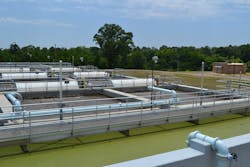How does a wastewater treatment plant become recognized as the "best regional wastewater treatment plant" only four months after its commissioning?
According to the mayor of McComb, Miss., at the groundbreaking ceremony for the McComb Regional Wastewater Treatment Plant in August 2008, the facility was destined to be “the most advanced, most energy-efficient and most cost-efficient wastewater treatment facility in the state."
Less than two years later in February 2010, the McComb facility was named the best regional wastewater treatment plant by the Mississippi Municipal League.
There’s plenty of credit to go around for the project’s success: a forward thinking administration for the city of McComb, an innovative facility design by Neel-Schaffer Inc., the skilled workmanship of Max Foote Construction Co. and the city’s public-private partner, Severn Trent Services, which was brought in as construction neared completion for the transition, commissioning, and ongoing plant operations and maintenance.
State-of-the-Art Biological Reactor
The McComb facility features a state-of-the-art vertical loop reactor (VLR) process with a Cannibal interchange biological reactor (IBR), one of only 12 such systems in the U.S.
A version of the activated sludge process, the VLR system provides a greater degree of water pollutant removal. In addition, the IBR process significantly reduces waste activated sludge, unlike the conventional activated sludge process, which produces a large volume of biosolids that must be disposed of.
The treatment plant is designed to produce a maximum flow of 15 million gal per day (mgd). Permitted for a maximum average flow of 5 mgd, it has produced an average of 2.5 to 3 mgd.
Increasing Plant Efficiency and Reducing Costs
Severn Trent Services has effectively implemented efficient process-control measures at the facility. In March 2010, the company installed the water information management system (WIMS). The WIMS database collects information from operators and laboratory technicians to determine the proper control parameters for efficient operations.
Numerous human interface procedures are constantly monitored and verified by both field and laboratory analytical tools to maintain peak process performance. After all laboratory data are input into the database, monthly operation reports are generated and NPDES discharge monitoring reports are produced.
Employees closely monitor the dissolved oxygen, pH, temperatures and oxygen reduction potential readings at various points through the VLR. The data are recorded daily and input in the WIMS system. Dissolved oxygen, pH and temperature of the influent and effluent are also measured daily, enabling plant staff to respond to issues quickly and make any necessary changes to maintain operational efficiency and permit compliance.
An in-house lab performs daily chemical analyses, which result in considerable cost savings compared to contract laboratory costs. The lab conducts analyses on BOD, COD, TSS, VSS, pH, ammonia nitrogen, alkalinity, settleable solids and fecal coliform.
The plant’s staff also produced cost efficiencies through ongoing plant maintenance practices. In August 2011, Severn Trent Services presented a rebate check of $3,179.40 to the city, representing savings achieved in the previous fiscal year against the plant’s annual maintenance budget of $30,000.
To uncover additional cost-reduction opportunities, Severn Trent Services commissioned its technical services group to provide a site energy management plan to the city. Recently completed, the plan suggests possible cost-savings measures at the plant, savings that at other plants have totaled as much as several hundred thousand dollars per year.
Regulatory Compliance
According to Severn Trent Services Senior Area Manager Stan Wright, regulatory compliance is a big reason why municipalities value public-private partnerships.
“Based on our experience providing safe drinking water and compliant wastewater treatment to more than 15 million people worldwide, our staff typically improves regulatory compliance significantly," he said. "For example, the NPDES established new BOD and ammonia nitrogen discharge limits of 7.3 mg/L BOD and 1.46 mg/L ammonia nitrogen to be in compliance by Jan. 1, 2011. We achieved compliance by May 31, 2010, seven months prior to the mandatory date.”
Staff also increased the average percentage of major pollutant removal from the regulatory compliance limit of 85% to 98.5%.
“Our operating services group is doing for the McComb facility what we are doing for approximately 400 water and wastewater treatment facilities in the U.S.: reducing costs, increasing operational efficiency and ensuring regulatory compliance," Wright said.
Diane Neiley is marketing manager at Severn Trent Services. Neiley can be reached at 215.283.3452 or [email protected].


